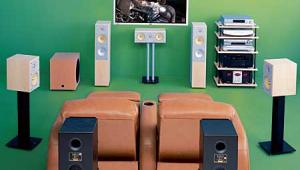Bass Management Boot Camp Page 3
Bass Management For Wusses
You think I’m gonna do your bass management settings for you? You need me to hold your hand? Well, forget it. But if you’re too lily-livered to do your own bass management, there are lots of receivers that do it for you.
Most of today’s better receivers and surround processors have auto setup built in. They use a microphone to measure the capabilities and configuration of your speaker system, and then automatically choose the best subwoofer crossover point as well as set levels and delay for each channel. Auto setup is included in all receivers equipped with room-equalization technology such as Audyssey Labs’ MultEQ and 2EQ, Pioneer’s MCACC, Trinnov Audio’s Optimizer, and Yamaha’s YPAO.
Set Up That Sub!
Even perfect bass management won’t fix poor sub-
woofer setup. After you set bass management but be-
fore you set the levels and delay on the receiver (or before you run the auto setup routine), you need to get off your goldbricking butt and get your subwoofer working right. So what are you going to do now?
Sir! Set up the subwoofer, sir!
Good. You’re finally starting to get it.
First, you have to set the subwoofer’s controls. Either select crossover bypass or turn the crossover frequency to its highest setting. If you have the subwoofer’s crossover set at 80 Hz and you also have the receiver in your crossover set for 80 Hz, you’ll “cascade” the two filters. This can result in a “hole” between the main speakers and the sub.
Second, set the subwoofer’s phase control. The best way to do this is by measuring, but you can also do it by ear. Start out with the phase set at 0°. If you’re measuring, perform a measurement from your listening position and look at the frequencies around the crossover point. Now flip the phase switch or turn the phase knob to 180°. Use whichever setting measures flatter at the crossover point. If your sub has a phase knob, you can also try in-between settings such as 90°.
To adjust phase by ear, play music with a melodic bass line; I use “Shower the People” from James Taylor’s Live at the Beacon Theatre DVD or the title track of Steely Dan’s Aja CD. Sit in your usual listening position, listen to the bass line, and then flip the phase setting. If the bass line sounds smoother and more even with one setting, use that one.
If you find through measurements that your room has a bass peak at or near the crossover frequency even after you’ve found the optimum phase setting on your sub, you can “underlap” the crossovers to reduce output at that frequency. Say your receiver is set for an 80-Hz crossover and you have a peak of 6 dB at 75 Hz. Try setting your sub’s crossover to 80 Hz and measure again from your listening position. If the peak remains, reduce the sub’s crossover frequency until it’s gone. You might try increasing your receiver’s crossover frequency to 100 Hz if you can, although this could negatively affect voice reproduction.
You can spend a whole day experimenting with subwoofer positioning, but one time-honored procedure will get you close in minutes. Place your subwoofer in your listening chair — that’s right, in your chair — and play something with a low-pitched melodic bass line. Now drop to your knees and start crawling around the front of your room. You heard me, bass maggots: crawl! While you’re crawling, listen to how even the bass line sounds in different positions. Find the position where the bass line sounds most even and put your subwoofer there.
Think you’re pretty smart, recruit? Well, prove it to me! It’s simple: Add a second subwoofer to smooth out the bass response and give you more consistent bass from seat to seat. Positioning is easy: Put one in each of the front corners of the room.
Once your sub is properly positioned, you can use an equalizer to improve the sound. Some receivers and subwoofers have a single-band equalizer built in; these let you flatten out your room’s most troublesome bass resonance. Auto room-equalization technologies, such as the Audyssey MultEQ built into many receivers, can fine-tune the bass response for you. If your receiver or surround processor lacks such a feature, try an outboard sub equalizer like the DSPeaker Anti-Mode 8033, the SVS AS-EQ1, or the Velodyne SMS-1.
Well, You Graduated
Whaddya want, a friggin’ medal? I got you better bass response, and all you had to do was crawl around on the floor, turn a few knobs, change a bunch of menu settings, carry a subwoofer around, hook up a microphone, and run some software.
But I gotta say I’m proud of you. You made it through a technical obstacle course that would have had lesser men and women crying for their mommies. And you won the battle against bad bass. Good job, recruit. Dis-missed!



















































